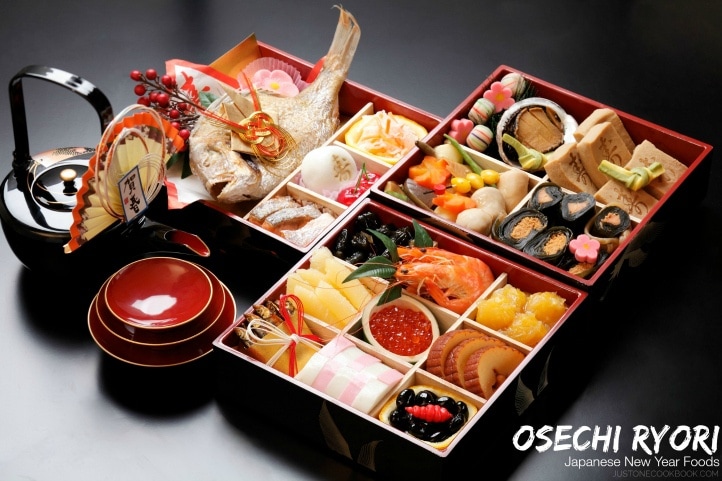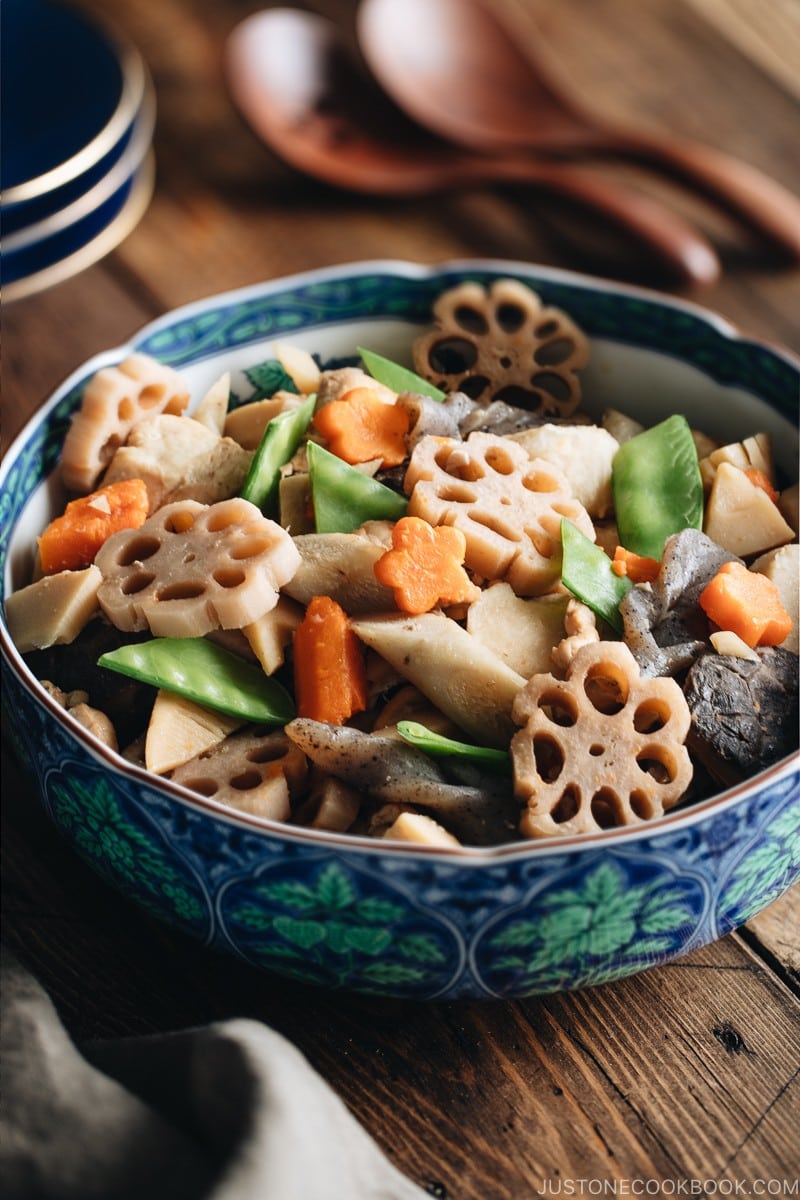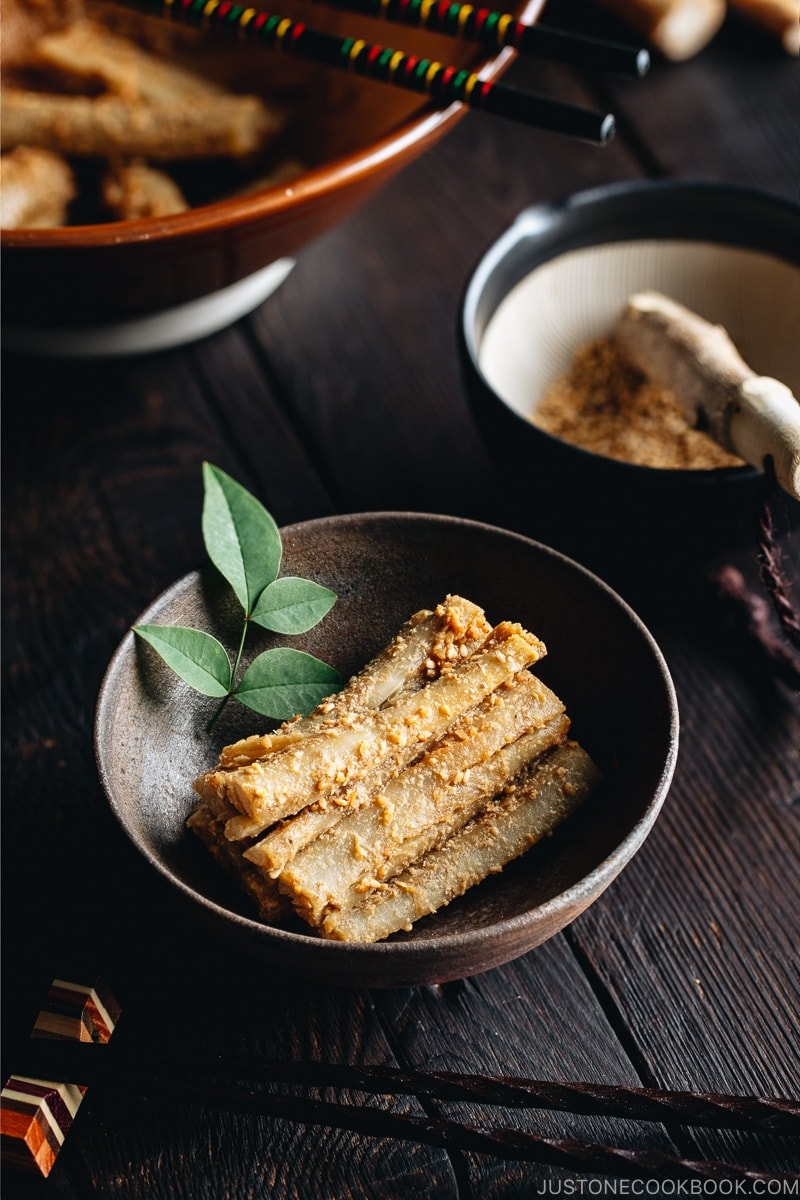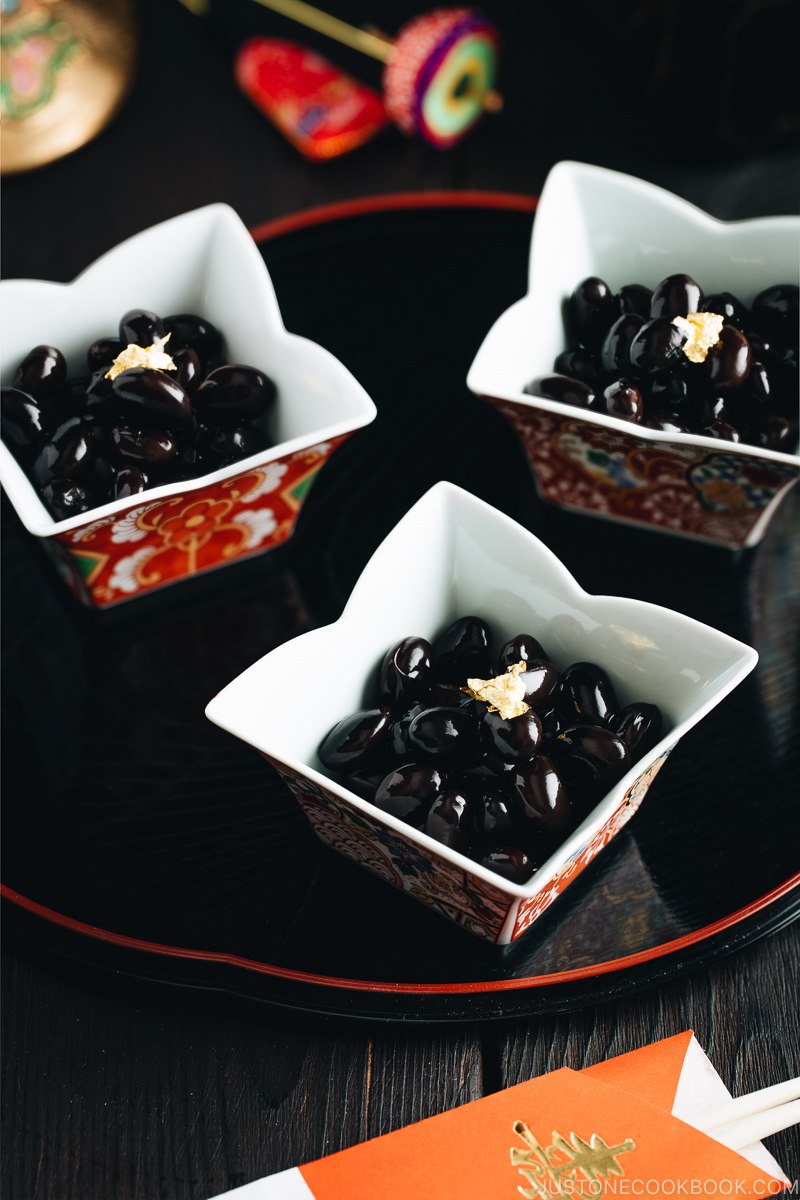
Osechi Ryori (御節料理) are the traditional foods enjoyed on New Year’s day in Japan. They come in an assortment of colorful dishes packed together in special boxes called jubako, which resemble bento boxes. Every dish of these traditional foods have special meaning in welcoming the New Year.
The Japanese celebrate the New Year Day with traditional New Year foods called Osechi Ryori (御節料理). It is considered the most important meal of the year as each dish serves as a well wishes for the coming year.
What is Osechi Ryori?
Similar to bento boxes, Osechi Ryori are usually packed in 2-3 layers of lacquer boxes (ojubako) and there are many dishes in each layer. The entire family would share one ojubako to enjoy on new year’s day. The multi-tiered boxes symbolize the hope that happiness & wealth come continuously, like the layers of lacquer ware.
To welcome the New Year with you, I’ve included a selection of popular Osechi Ryori dishes below. You will find some traditional dishes along with a mix of modern Japanese favorites that are often served during the holiday. Each recipe also comes with a video that guides you through the cooking process.
I hope you enjoy the spread & don’t miss the delicious desserts at the end!
![]()
13 Popular Osechi Ryori Dishes
- Datemaki (Sweet Rolled Omelette) 伊達巻
- Kuri Kinton (Candied Chestnut with Sweet Potatoes) 栗きんとん
- Namasu (Daikon & Carrot Salad) 紅白なます
- Chikuzenni / Nishime (Simmered Chicken & Vegetables) 筑前煮/煮しめ
- Tazukuri (Candied Sardines) 田作り
- Kuromame (Sweet Black Soybeans) 黒豆
- Kazunoko (Herring Roe) 数の子
- Kamaboko (Fish Cake with Salmon Roe) 蒲鉾いくらのせ
- Ebi no Umani (Simmered Shrimp) えびのうま煮
- Shake no Kobumaki (Salmon Kombu Roll) 鮭の昆布巻き
- Kikka Kabu (Pickled Chrysanthemum Turnip) 菊花かぶ
- Decorative Kamaboko (Fish Cakes)かまぼこ
- Tataki Gobo (Pounded Burdock Root) たたきごぼう
1. Datemaki (Sweet Rolled Omelette) 伊達巻
Typically served in a lacquered jubako (special square boxes similar to lunch box), Datemaki is sweet rolled omelette that makes a very popular Japanese New Year’s food. It is by far my favorite dish among the new year foods. And I hope you give this delicate looking omelette a try too!
2. Kuri Kinton (Candied Chestnut with Sweet Potatoes) 栗きんとん
Kurikinton literary means “chestnut gold mash”, which symbolizes economic fortune and wealth. It’s important for New Year meal to bring good luck and prosperity. If you make this dish, please use Japanese Sweet Potatoes for its bright yellow color. Not only they are sweeter than regular sweet potatoes, yellow is also an auspicious color for the new year.
3. Namasu (Daikon & Carrot Salad) 紅白なます
Namasu is a daikon and carrot salad that is lightly pickled in sweetened vinegar. This dish was introduced to Japan from China around 700s (Nara period) and it is especially enjoyed during the New Year in Japan. Since red and white are considered celebratory colors in Japan, you will see these colors being used in many traditional ceremonies. This salad is easy to make and can be prepared ahead of time.

4. Chikuzenni (Simmered Chicken & Vegetables) 筑前煮
Chikuzenni is a classic Japanese dish often served on New Year’s Day, but my mom makes it regularly because it was my family’s favorite Nimono (Japanese simmered dish). This is also a popular side dish for bento because it can be made in advance and still tastes great at room temperature. For New Year’s dish, the vegetables and konnyaku are cut into fancy shapes to celebrate the occasion. If you have a pressure cooker, follow my Instant Pot Nishime recipe.
5. Tazukuri (Candied Sardines) 田作り
Made of roasted baby sardines & coated in a sweet soy sauce glaze, Tazukuri is another popular dish for osechi ryori. We eat tazukuri on the New Year’s day as it symbolizes a bountiful harvest. Tazukuri (田作り) literally translates to “making (作り) rice paddy (田)” as sardines were once used as fertilizers for rice fields.
6. Kuromame (Sweet Black Soybeans) 黒豆
Kuromame literally means “black bean (黒豆)” in Japanese, and it is often served on New Years Day as a part of Osechi Ryori. The shinny black beans make a beautiful contrast to red lacquer jubako container, which holds all different kinds of colorful traditional meals. Eating kuromame also is considered good for your health for the new year. If you want to cut down on cooking time, you can use your a pressure cooker and follow this Instant Pot Kuromame recipe.
7. Kazunoko (Herring Roe) 数の子
We enjoy this golden colored Kazunoko on the New Year’s day as it symbolizes prosperous family and many offsprings. This prized delicacy has unique crunchy texture and it’s one of the most popular dishes among Osechi Ryori.
8. Kamaboko (Fish cake with Salmon Roe) 蒲鉾いくらのせ
With its elegant presentation, Kamaboko with Salmon Roe makes an impressive addition to your osechi ryori. You’d be surprised how easy it is to make the recipe. Simply make small slits across the Kamaboko (fish cake), stuff in shiso leaf, and top with golden salmon roe.
9. Ebi no Umani (Simmered Shrimp) えびのうま煮
Simmered shrimp cooked in dashi soy sauce and soaked overnight, this beautiful dish adds a bright color and delicious flavor to your Osechi Ryori.
10. Salmon Kombu Roll 鮭の昆布巻き
Flavorful salmon rolled up in kombu and tied with kanpyo (gourd strips), Salmon Kombu Roll is a traditional Japanese dish for the New Year. Representing the secrets of perennial youth and long life, you may be tempted to devour more than one of these exquisite appetizers.
11. Pickled Chrysanthemum Turnip 菊花かぶ
Simple decorative touches on a vegetable can transform a dish from ordinary to special. These Pickled Chrysanthemum Turnips will bring your Osechi Ryori game to the next level. And you only need some basic cutting techniques!
12. 7 Beautiful Designs to Cut Japanese Fish Cake (Kamaboko) かまぼこの飾り切り
Two Japanese fish cakes (Kamaboko), seven beautiful designs to cut Japanese fish cake! Make ordinary fish cake into decorative designs on this Oshogatu (Japanese New Year)!

13. Pounded Burdock Root with Sesame Sauce (Tataki Gobo) たたきごぼう
![]()
12 Popular Side Dishes & Desserts to Serve with Osechi Ryori
1. Ozoni (Kanto-style) 関東風お雑煮
Ozoni (Japanese New Year Mochi Soup) is clear dashi based mochi soup with chicken and seasonal vegetables, which is enjoyed in Kanto region (Eastern Japan). This comforting winter soup usually includes toasted mochi, chicken, and Japanese mustard spinach and served with varieties of osechi ryori.
2. Ozoni (Kansai-style) 関西風お雑煮
This Kansai-style Ozoni is a miso-based soup enjoyed in the morning on New Year’s Day. The soup includes mochi (rice cake), and the preparation varies by region and household. My recipe is an adaptation from my mom’s recipe where I include leafy green vegetables and yuzu peel.
3. Mochi (Japanese Rice Cakes) お餅各種
From sweet to savory, there are various types of mochi (Japanese rice cake) we enjoy in Japan. For savory dishes, mochi is used as a topping for Ozoni, hot udon noodle soup, or inside Okonomiyaki. For sweet dishes, you will find Mochi Ice Cream, Zenzai (Oshiruko), Strawberry Daifuku and so on. So for Japanese New Year, you have the perfect excuse to enjoy them all.
4. Anko (Sweet Red Bean Paste) 餡子
Red bean paste is used as a filling in many delicious Japanese sweets and desserts. This Pressure Cooker Anko recipe is an easy way to prepare the sweet bean paste without much hassle. Once it’s cooked, you are set to make all sorts of mochi or Dorayaki and Taiyaki.
5. Cucumber Wrapped Sushi きゅうりの軍艦巻き
These refreshing Cucumber Wrapper Sushi could be served as appetizer for your New Year celebration. Once the rice is cooked, you can quickly assemble the sushi right before you serve. If you don’t eat raw fish, you can substitute with smoked salmon or simply create your own.
6. Otoro Sushi 大トロ寿司
Although it is not part of osechi ryori, sushi is regarded a celebratory food in Japan and most holidays include one variation of sushi or another. Japanese New Year makes a special occasion to enjoy otoro sushi, where you feast on the most valued part of the tuna belly.
7. Hosomaki (Thin Sushi Rolls) 細巻き
Hosomaki (Thin Sushi Rolls) are an easy and fun dish to serve during your New Year’s get-together. To get started, you just need a few ingredients like tuna, cucumber, nori, and Japanese short grain rice.
8. Futomaki (Thick Sushi Rolls) 太巻き
This traditional thick sushi roll Futomaki is typically filled with various vegetables and sometimes include cooked fish like unagi. This colorful sushi roll is perfect special holidays and celebrations.
9. Zenzai (Red Bean Soup with Rice Cakes) ぜんざい
Zenzai is a thick sweet dessert soup made of azuki red beans and often served with mochi (toasted rice cake). Although is not considered part of osechi ryori, this delicious dessert soup is a comforting treat for Japanese people especially during the winter time.
10. Green Tea Zenzai 抹茶ぜんざい
For a different variety of zenzai, I recommend this unique Matcha Zenzai, where red bean paste with soft mochi are served in a green tea soup. This exquisite sweet can be enjoyed hot or cold. If you have last-minute guests visiting, you can prepare it easily and serve as a snack or dessert.
11. Yuzu Sorbet 柚子のシャーベット
Yuzu is commonly used in Japanese cuisine when it’s in season in fall or winter. I think it’s wonderful to make Yuzu Sorbet to round up the Japanese New Year dishes for a bright future. It also helps to refresh the palate for the delicious foods we enjoy during the holiday.
12. Mizu Yokan 水羊羹
A chilled Japanese red bean jelly, Mizu Yokan is a traditional sweet in Japan. Shaped like a rectangular block with a firm texture, my recipe includes golden chestnuts inside the jelly for a festive touch. This Mizu Yokan is a great edible gift if you are visiting your family for the New Year’s.
![]()
Wish to Learn More about Japanese New Year?
Click here to find out more about how Japanese people celebrate this annual festival.
In the meantime, I hope you enjoy making these Osechi Ryori recipes during the New Year’s holiday! If you make one of these recipes, snap a picture and hashtag it #JustOneCookbook. I love to see your creations on Instagram, Facebook, & Twitter! Thank you so much for reading and till next time!
Don’t want to miss a recipe? Sign up for the FREE Just One Cookbook newsletter delivered to your inbox! And stay in touch with me on Facebook, Google+, Pinterest, and Instagram for all the latest updates.
Editor’s Note: Original post was published on Dec 27, 2015. The content has been updated in December 2017.
























